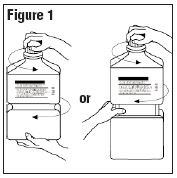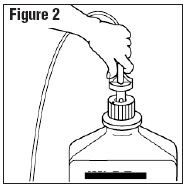Mannitol by B. Braun Medical Inc. MANNITOL irrigant
Mannitol by
Drug Labeling and Warnings
Mannitol by is a Prescription medication manufactured, distributed, or labeled by B. Braun Medical Inc.. Drug facts, warnings, and ingredients follow.
Drug Details [pdf]
- SPL UNCLASSIFIED SECTION
-
DESCRIPTION
Each 100 mL contains:
Mannitol USP 5 g
Water for Injection USP qspH: 5.5 (4.5–7.0)
Calculated Osmolarity: 275 mOsmol/literThe formula of the active ingredient is:
Ingredient Molecular Formula Molecular Weight Mannitol USP 
182.17 5% Mannitol Irrigation is a prediluted, sterile, nonpyrogenic aqueous solution suitable for urologic irrigation. The solution is approximately isotonic.
Mannitol USP is chemically designated D-mannitol (C6H14O6). Mannitol is a hexitol naturally occurring in fruits and vegetables and is produced commercially by the reduction of glucose.
The solution contains no antimicrobial or bacteriostatic agents or added buffers.
The plastic container is a copolymer of ethylene and propylene formulated and developed for parenteral drugs. The copolymer contains no plasticizers and exhibits virtually no leachability. The plastic container is also virtually impermeable to vapor transmission and therefore, requires no overwrap to maintain the proper drug concentration. The safety of the plastic container has been confirmed by biological evaluation procedures. The material passes Class Vl testing as specified in the U.S. Pharmacopeia for Biological Tests — Plastic Containers. These tests have shown that the container is nontoxic and biologically inert.
The PIC™ Container is PVC-free and DEHP-free.
-
CLINICAL PHARMACOLOGY
In humans, mannitol is confined to the extracellular space and is only slightly metabolized. It is rapidly excreted in the urine. When mannitol is absorbed intravascularly, it produces osmotic diuresis and will be excreted by the kidneys.
Mannitol is nonelectrolytic and is, therefore, nonconductive, making it suitable for urologic irrigation during electrosurgical procedures.
5% Mannitol is a nonhemolytic irrigating solution.
- INDICATIONS AND USAGE
- CONTRAINDICATIONS
-
WARNINGS
FOR UROLOGIC IRRIGATION ONLY. NOT FOR INJECTION.
Solutions for urologic irrigation must be used with caution in patients with severe cardiopulmonary or renal dysfunction.
Since irrigating fluids used during transurethral prostatectomy have been demonstrated to enter the systemic circulation in relatively large volumes, any irrigation solution must be regarded as a systemic drug.
Absorption of large amounts of fluids containing mannitol and the resultant osmotic diuresis may significantly affect cardiopulmonary and renal dynamics.
Do not warm above 150°F (66°C)
After opening container, its contents should be used promptly to minimize the possibility of bacterial growth or pyrogen formation.
Discard unused portion of irrigating solution since it contains no preservative.
-
PRECAUTIONS
General
Use aseptic technique when preparing and administering sterile irrigation solutions.
Use only if solution is clear and container and seal are intact.
Cardiovascular status, especially in patients with cardiac disease, should be carefully determined before and during transurethral resection of the prostate when using 5% Mannitol as an irrigant. The fluid absorbed into the systemic circulation via severed prostatic veins may produce significant extracellular fluid expansion and lead to fulminating congestive heart failure.
Shift of sodium-free intracellular fluid into the extracellular compartment following systemic absorption of 5% Mannitol may lower serum sodium concentration and aggravate pre-existing hyponatremia.
Excessive loss of water and electrolytes may lead to serious imbalances. Continuous administration of 5% Mannitol may cause loss of water in excess of electrolytes and produce hypernatremia.
Sustained diuresis from transurethral irrigation with 5% Mannitol may obscure and intensify inadequate hydration or hypovolemia.
When used for irrigation via appropriate irrigation equipment, the administration set should be attached promptly. Unused portions should be discarded and a fresh container of appropriate size used for the start up of each cycle or repeat procedure. For repeated irrigations of urethral catheters, a separate container should be used for each patient.
Carcinogenesis, Mutagenesis, Impairment of Fertility
Studies with 5% Mannitol Irrigation have not been performed to evaluate carcinogenic potential, mutagenic potential, or effects on fertility.
Pregnancy
Teratogenic Effects
Pregnancy Category C
Animal reproduction studies have not been conducted with 5% Mannitol Irrigation. It is also not known whether 5% Mannitol Irrigation can cause fetal harm when administered to a pregnant woman or can affect reproduction capacity. 5% Mannitol Irrigation should be given to a pregnant woman only if clearly needed.
Nursing Mothers
Caution should be exercised when 5% Mannitol Irrigation is administered to a nursing woman.
Geriatric Use
Clinical studies of 5% Mannitol Irrigation did not include a sufficient number of patients age 65 years and over to determine whether they respond differently from younger subjects. Other reported clinical experience has not identified differences in responses between elderly and younger patients. In general, dose selection for an elderly patient should be cautious, reflecting the greater frequency of decreased hepatic, renal, or cardiac function, and of concomitant disease or other drug therapy.
This drug is known to be substantially excreted by the kidney, and the risk of toxic reactions to this drug may be greater in patients with impaired renal function. Because elderly patients are more likely to have decreased renal function, care should be taken in dose selection, and it may be useful to monitor renal function. See WARNINGS.
-
ADVERSE REACTIONS
Occasional adverse reactions to intravenous mannitol infusions have been reported. These include fluid and electrolyte disturbances, such as acidosis, electrolyte loss, marked diuresis, urinary retention, edema, dryness of the mouth, thirst and dehydration, cardiovascular/pulmonary disorders such as pulmonary congestion, hypotension, tachycardia, angina-like pain, and thrombophlebitis, and other general reactions such as blurred vision, convulsions, nausea, vomiting, rhinitis, chills, vertigo, backache, and urticaria.
If an adverse reaction does occur, discontinue administration of the irrigant, evaluate the patient, institute appropriate therapeutic countermeasures and save the remainder of the fluid for examination, if deemed necessary.
-
OVERDOSAGE
In the event of dehydration or fluid or solute overload, discontinue the irrigant, evaluate the patient and institute appropriate corrective treatment. See WARNINGS, PRECAUTIONS, and ADVERSE REACTIONS.
-
DOSAGE AND ADMINISTRATION
As required for urologic irrigation.
5% Mannitol Irrigation should be administered only by the appropriate transurethral urologic instrumentation.
Some additives may be incompatible. Consult with pharmacist. When introducing additives, use aseptic techniques. Mix thoroughly. Do not store.
Solutions should be inspected visually for particulate matter and discoloration prior to administration, whenever solution and container permits.
-
HOW SUPPLIED
5% Mannitol Irrigation is supplied sterile and nonpyrogenic in PIC™ (Plastic Irrigation Containers). The 2000 mL containers are packaged 8 per case and the 4000 mL containers are packaged 4 per case.
NDC Cat. No. Size 5% Mannitol Irrigation
(Canada DIN 01963953)0264-2303-50 R6515-01 2000 mL 0264-2303-70 R6517 4000 mL - SPL UNCLASSIFIED SECTION
-
Directions for Use of PIC™ (Plastic Irrigation Containers)
Not for injection.
Aseptic technique is required.
1. Caution – Before use, perform the following checks:
(a) Read the label. Ensure solution is the one ordered and is within the expiration date.(b) Invert container and inspect the solution in good light for cloudiness, haze, or particulate
matter; check the container for leakage or damage. Any container which is suspect
should not be used.Use only if solution is clear and container and seal are intact.
Single dose container.
2. Outer Closure Removal – Grasp the container with one hand and turn the breakaway ring
counterclockwise with the other hand until slight resistance is felt. Then, twisting the
container in the opposite direction, turn the breakaway ring sharply until the entire outer
cap is loose and can be lifted off.

3. Connect the administration set through the sterile port according to set instructions or
remove screw cap and pour.

4. Do not warm above 150°F to assure minimal bottle distortion. Keep bottles upright.
- SPL UNCLASSIFIED SECTION
-
PRINCIPAL DISPLAY PANEL - 2000 mL Label
5% Mannitol Irrigation
For Urologic Irrigation
REF R6515-01
NDC: 0264-2303-50
DIN 019639532000 mL
Lot
Exp.Each 100 mL contains:
Mannitol USP 5 g
Water for Injection USP qspH: 5.5 (4.5-7.0)
Calc. Osmolarity: 275 mOsmol/literNot for Injection: Use only if
solution is clear and container
and seal are intact.Sterile, nonpyrogenic.
Single dose container.Warning: Do not warm above
150°F (66°C).Recommended Storage:
Room temperature (25°C).
Avoid excessive heat.
Protect from freezing.
See Package Insert.Rx only
PVC-free and DEHP-freeB. Braun Medical Inc.
Irvine, CA 92614-5895 USA
Made in USAIn Canada, distributed by:
B. Braun Medical Inc.
Scarborough, Ontario M1H 2W4Y37-002-334

-
INGREDIENTS AND APPEARANCE
MANNITOL
mannitol irrigantProduct Information Product Type HUMAN PRESCRIPTION DRUG Item Code (Source) NDC: 0264-2303 Route of Administration IRRIGATION Active Ingredient/Active Moiety Ingredient Name Basis of Strength Strength MANNITOL (UNII: 3OWL53L36A) (MANNITOL - UNII:3OWL53L36A) MANNITOL 5 g in 100 mL Inactive Ingredients Ingredient Name Strength WATER (UNII: 059QF0KO0R) Packaging # Item Code Package Description Marketing Start Date Marketing End Date 1 NDC: 0264-2303-50 8 in 1 CASE 02/10/1978 1 2000 mL in 1 CONTAINER; Type 0: Not a Combination Product 2 NDC: 0264-2303-70 4 in 1 CASE 02/10/1978 2 4000 mL in 1 CONTAINER; Type 0: Not a Combination Product Marketing Information Marketing Category Application Number or Monograph Citation Marketing Start Date Marketing End Date NDA NDA016772 02/10/1978 Labeler - B. Braun Medical Inc. (002397347)
© 2025 FDA.report
This site is not affiliated with or endorsed by the FDA.